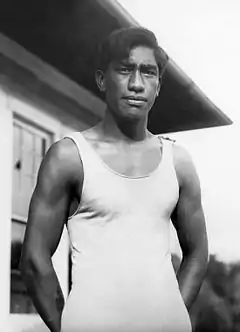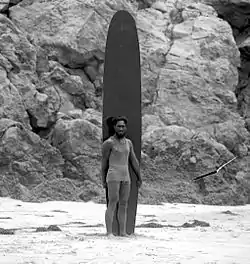Duke Kahanamoku
Duke Paoa Kahinu Mokoe Hulikohola Kahanamoku (August 24, 1890 – January 22, 1968) was a Native Hawaiian competition swimmer who popularized the ancient Hawaiian sport of surfing. He was born towards the end of the Kingdom of Hawaii, just before the overthrow, living into statehood as a United States citizen. He was a five-time Olympic medalist in swimming. Duke was also a Scottish Rite Freemason,[4] a Shriner, a law enforcement officer, an actor, a beach volleyball player and a businessman.[5]
 Duke Kahanamoku c. 1912 | |||||||||||||||||||||||
| Personal information | |||||||||||||||||||||||
|---|---|---|---|---|---|---|---|---|---|---|---|---|---|---|---|---|---|---|---|---|---|---|---|
| Full name | Duke Paoa Kahinu Mokoe Hulikohola Kahanamoku | ||||||||||||||||||||||
| Nickname(s) | "Duke," "The Big Kahuna"[1] | ||||||||||||||||||||||
| National team | |||||||||||||||||||||||
| Born | August 24, 1890 Haleʻākala, Honolulu, Kingdom of Hawaii | ||||||||||||||||||||||
| Died | January 22, 1968 (aged 77) Honolulu, Hawaii[2] | ||||||||||||||||||||||
| Height | 6 ft 1 in (185 cm)[2][3] | ||||||||||||||||||||||
| Weight | 190 lb (86 kg)[2] | ||||||||||||||||||||||
| Sport | |||||||||||||||||||||||
| Sport | Swimming | ||||||||||||||||||||||
| Strokes | Freestyle | ||||||||||||||||||||||
| Club | Waikiki Beach Boys | ||||||||||||||||||||||
Medal record
| |||||||||||||||||||||||
Early years
According to Kahanamoku, he was born in Honolulu at Haleʻākala, the home of Bernice Pauahi Bishop which was later converted into the Arlington Hotel.[6] He had five brothers and three sisters, including Samuel Kahanamoku and Sargent Kahanamoku. In 1893, the family moved to Kālia, Waikiki (near the present site of the Hilton Hawaiian Village), to be closer to his mother's parents and family. Duke grew up with his siblings and 31 Paoa cousins.[5]:17 Duke attended the Waikiki Grammar School, Kaahumanu School, and the Kamehameha Schools, although he never graduated because he had to quit to help support the family.[7]
"Duke" was not a title or a nickname, but a given name. He was named after his father, Duke Halapu Kahanamoku, who was christened by Bernice Pauahi Bishop in honor of Prince Alfred, Duke of Edinburgh, who was visiting Hawaii at the time. His father was a policeman. His mother Julia Paʻakonia Lonokahikina Paoa was a deeply religious woman with a strong sense of family ancestry.
Even though not of the formal Hawaiian Royal Family, his parents were from prominent Hawaiian ohana (family); the Kahanamoku and the Paoa ohana were considered to be lower-ranking nobles, who were in service to the aliʻi nui or royalty.[6] His paternal grandfather was Kahanamoku and his grandmother, Kapiolani Kaoeha (sometimes spelled Kahoea), a descendant of Alapainui. They were kahu, retainers and trusted advisors of the Kamehamehas, to whom they were related. His maternal grandparents Paoa, son of Paoa Hoolae and Hiikaalani, and Mele Uliama were also of aliʻi descent.[5]:9[8]
Growing up on the outskirts of Waikiki, Kahanamoku spent his youth as a bronzed beach boy. At Waikiki Beach he developed his surfing and swimming skills. In his youth, Kahanamoku preferred a traditional surf board, which he called his "papa nui", constructed after the fashion of ancient Hawaiian "olo" boards. Made from the wood of a koa tree, it was 16 feet (4.9 m) long and weighed 114 pounds (52 kg). The board was without a skeg, which had yet to be invented. In his later career, he would often use smaller boards but always preferred those made of wood.
On August 11, 1911, Kahanamoku was timed at 55.4 seconds in the 100 yards (91 m) freestyle, beating the existing world record by 4.6 seconds, in the salt water of Honolulu Harbor. He also broke the record in the 220 yd (200 m) and equaled it in the 50 yd (46 m). But the Amateur Athletic Union (AAU), in disbelief, would not recognize these feats until many years later. The AAU initially claimed that the judges must have been using alarm clocks rather than stopwatches and later claimed that ocean currents aided Kahanamoku.[9]
He was initiated, passed and raised to the sublime degree of Master Mason in Hawaiian Lodge Masonic Lodge No 21[10][11] [12] and was also a Noble (member) of the Shriners fraternal organization.[13]
Career

Kahanamoku easily qualified for the U.S. Olympic swimming team in 1912. At the 1912 Summer Olympics in Stockholm, he won a gold medal in the 100-meter freestyle, and a silver medal with the second-place U.S. team in the men's 4×200-meter freestyle relay. During the 1920 Olympics in Antwerp, he won gold medals both in the 100 meters (bettering fellow Hawaiian Pua Kealoha) and in the relay. He finished the 100 meters with a silver medal during the 1924 Olympics in Paris, with the gold going to Johnny Weissmuller and the bronze to Duke's brother, Samuel Kahanamoku. At age 34, this was Kahanamoku's last Olympic medal.[2] He also was an alternate for the U.S. water polo team at the 1932 Summer Olympics.
Post Olympic Career
Between Olympic competitions, and after retiring from the Olympics, Kahanamoku traveled internationally to give swimming exhibitions. It was during this period that he popularized the sport of surfing, previously known only in Hawaii, by incorporating surfing exhibitions into these visits as well. His surfing exhibition at Sydney's Freshwater Beach on December 24, 1914, is widely regarded as a seminal event in the development of surfing in Australia.[14] The board that Kahanamoku built from a piece of pine from a local hardware store is retained by the Freshwater Surf Club. There is a statue of Kahanamoku on the Northern headland of Freshwater Beach, New South Wales.[15] He made surfing popular in mainland America first in 1912 while in Southern California.
During his time living in Southern California, Kahanamoku performed in Hollywood as a background actor and a character actor in several films. In this way, he made connections with people who could further publicize the sport of surfing. Kahanamoku was involved with the Los Angeles Athletic Club, acting as a lifeguard and competing in both swimming and water polo teams.
While living in Newport Beach, California on June 14, 1925, Kahanamoku rescued eight men from a fishing vessel that capsized in heavy surf while attempting to enter the city's harbor.[16] Twenty nine sport fishermen went into the water, and seventeen eventually drowned. Using his surfboard Duke was able to make repeated trips back & forth from shore to the capsized ship increasing the number of those rescued.[17] Two other surfers saved four more fishermen. At the time the Newport Beach police chief called Duke's efforts "The most superhuman surfboard rescue act the world has ever seen". It also led to lifeguards across the US to begin using surfboards as standard equipment for water rescues.[3]
In 1940, Kahanamoku married Nadine Alexander, who accompanied him when he traveled. He was the first person to be inducted into both the Swimming Hall of Fame and the Surfing Hall of Fame. The Duke Kahanamoku Invitational Surfing Championships in Hawaii, the first major professional surfing contest event ever held in the huge surf on the North Shore of Oahu was named in his honor. He is a member of the U.S. Olympic Hall of Fame. Kahanamoku went on to serve as the Sheriff of Honolulu, Hawaii from 1932 to 1961, completing 13 consecutive terms. During that period he also appeared in a number of television programs and films, such as Mister Roberts (1955), and was well-liked throughout the Hollywood community.
Kahanamoku was a friend and surfing companion of heiress Doris Duke, who built a home (now a museum) on Oahu named Shangri-la.
Duncan v. Kahanamoku
In 1946, Kahanamoku was the pro forma defendant in the landmark Supreme Court case Duncan v. Kahanamoku. While Kahanamoku was a military police officer during World War II, he arrested Duncan, a civilian shipfitter, for public intoxication. At the time, Hawaii, not yet a state, was being administered under the Hawaiian Organic Act which effectively instituted martial law on the island. Duncan was therefore tried by a military tribunal and appealed to the Supreme Court. In a post hoc ruling, the court ruled that trial by military tribunal was, in this case, unconstitutional.[18]
Death and legacy
Kahanamoku died of a heart attack on January 22, 1968, at the age of 77.[19] For his burial at sea a long motorcade of mourners, accompanied by a 30-man police escort, moved across town to Waikiki Beach. Reverend Abraham Akaka, the pastor of Kawaiahao Church, performed the service, a group of beach boys sang Hawaiian songs, including "Aloha Oe", and his ashes were scattered into the ocean.
Statues and monuments
The City of Honolulu commemorated this Waikiki Beach burial site in 1990 with a 9-foot cast bronze statue of Kahanamoku by Jan Gordon Fisher that shows Kahanamoku with outstretched arms in front of his surfboard, flanked by honorary Hawaiian spears and surrounded by a dedication plaque and historic information marker.[20] The statue's orientation that placed Kahanamoku's back to the sea was initially criticized as being contrary to Hawaiian custom. This placement and orientation created a highly popular local shrine and tourist locale; the statue's outstretched arms are continuously adorned with fresh leis and the locale hosts annual tribute ceremonies and thousands of yearly tourist visits.[20] In 1994 a statue of Kahanamoku by Barry Donohoo was inaugurated in Freshwater, NSW, Australia as the showpiece of the Australian Surfers Walk of Fame.[21]
On February 28, 2015, a monument featuring a replica of Kahanamoku's surfboard was unveiled at New Brighton beach, Christchurch, New Zealand in honor of the 100th anniversary of Kahanamoku's visit to New Brighton.[22]
Additional tributes
Hawaii music promoter Kimo Wilder McVay capitalized on Kahanamoku's popularity by naming his Waikiki showroom "Duke Kahanamoku's" at the International Market Place,[23] and giving Kahanamoku a financial interest in the showroom in exchange for the use of his name. It was a major Waikiki showroom in the 1960s and is remembered as the home of Don Ho & The Aliis from 1964 through 1969. The showroom continued to be known as Duke Kahanamoku's until Hawaii showman Jack Cione bought it in the mid-1970s and renamed it Le Boom Boom.
Kahanamoku's name is also used by Duke's Canoe Club & Barefoot Bar, as of 2016 known as Duke's Waikiki, a beachfront bar and restaurant in the Outrigger Waikiki on the Beach Hotel. There is a chain of restaurants named after him in California, Florida and Hawaii called Duke's.
On August 24, 2002, the 112th anniversary of Kahanamoku's birth, the U.S. Postal Service issued a first-class commemorative stamp with Duke's picture on it. The First Day Ceremony was held at the Hilton Hawaiian Village in Waikiki and was attended by thousands. At this ceremony, attendees could attach the Duke stamp to an envelope and get it canceled with a First Day of Issue postmark. These first day covers are very collectible.[24]
On August 24, 2015, a Google Doodle honored the 125th anniversary of Duke Kahanamoku's birthday.[25]
Filmography
| Year | Title | Role | Notes | |
|---|---|---|---|---|
| 1925 | Adventure | Noah Noa | ||
| The Pony Express | Indian Chief | Uncredited | ||
| No Father to Guide Him | The Lifeguard | Short | ||
| Lord Jim | Tamb Itam | |||
| 1926 | Old Ironsides | Pirate Captain | Uncredited | |
| 1927 | Hula | Hawaiian Boy | Uncredited | |
| Isle of Sunken Gold | Lono | |||
| 1928 | Woman Wise | Guard | ||
| 1929 | The Rescue | Jaffir | ||
| Where East Is East | Wild Animal Trapper | Uncredited | ||
| 1930 | Girl of the Port | Kalita | ||
| Isle of Escape | Manua | |||
| 1931 | Around the World with Douglas Fairbanks | Himself | Documentary | |
| The Black Camel | bit part as surf instructor | at 0:01:36 | ||
| 1948 | Wake of the Red Witch | Ua Nuke | ||
| 1955 | Mister Roberts | Native Chief | (as Duke Kahanamoko) | |
| 1957 | This Is Your Life | Himself | Episode: "Duke Kahanamoku" | |
| 1967 | Free and Easy | Himself | Documentary | |
| Surfari | Himself | Documentary | ||
| Source:[26] | ||||
See also
- Google Arts & Culture - "Duke Paoa Kahanamoku"
- Google Maps - Public Art "Duke Kahanamoku"
- Duke Paoa Kahanamoku Lagoon
- List of multiple Olympic gold medalists
- List of Olympic medalists in swimming (men)
- World record progression 100 metres freestyle
- World record progression 4 × 200 metres freestyle relay
References
- Editor for Surfer Today. "10 interesting facts about Duke Kahanamoku". Surfertoday. Retrieved November 8, 2019.CS1 maint: extra text: authors list (link)
- Murphy, Kelly with Hallie Fryd (2013). Historical Heartthrobs: 50 Timeless Crushes-From Cleopatra to Camus. USA: Zest Books. p. 109. ISBN 9781936976102.
- See, Jen (August 24, 2015). "5 Things You Didn't Know About Duke Kahanamoku". MensJournal.com. Men's Journal. Retrieved August 25, 2015.
- "History of the Scottish Rite Masonic Lodge in Honolulu". honoluluscottishritebodies.org. Archived from the original on September 30, 2018. Retrieved September 30, 2018.
- Hall, Sandra Kimberly. (2004). Duke: A Great Hawaiian. Honolulu, HI: Bess Press. ISBN 1-57306-230-8.
- Nendel, James D.; The Pennsylvania State University (2006). Duke Kahanamoku: Twentieth Century Hawaiian Nonarch. ProQuest. pp. 1–13. ISBN 0-542-84320-X.
- Herbert G. Gardiner, PGS, Grand Historian. "Duke Kahanamoku Paoa". Archived from the original on September 28, 2011. Retrieved March 22, 2011.CS1 maint: multiple names: authors list (link)
- Brennan, Joe (1968). Duke of Hawaii. pp. 74–76.
- "Duke Kahanamoku. Notable Asian Americans. Gale Research, 1995. Reproduced in Biography Resource Center. Farmington Hills, Mich.: Thomson Gale. 2007.
- "Athletes and other sport figures notable masons". Archived from the original on July 14, 2013. Retrieved September 30, 2018.
- "Famous Masons". Archived from the original on December 24, 2011. Retrieved September 30, 2018.
- "Athletes and Other Sports Figures in Freemasonry". Archived from the original on September 29, 2013. Retrieved September 30, 2018.
- "Duke Paoa Kahanamoku Kahinu Mokoe Hulikohola (1890 – 1968)". St. John's Lodge No 2, New Castle Delaware. Archived from the original on September 30, 2018. Retrieved September 30, 2018.
Duke was a member of Hawaii Lodge #22, The Scottish Rite and the Shriners.
- Osmond, Gary. (2010). "'Honolulu Māori': Racial Dimensions of Duke Kahanamoku's Tour of Australia and New Zealand". New Zealand Journal of History. 44 (1): 22–34.
- Design, UBC Web. "Duke Kahanamoku | Monument Australia". monumentaustralia.org.au. Retrieved October 3, 2017.
- "Kahanamoku Helps Save 13 in Launch. Hawaiian Swimmer and Others Go to Their Rescue With Surf Boards. Five Are Drowned". The New York Times. June 16, 1925. Retrieved November 2, 2010.
... swimming star, Duke Kahanamoku and his fellow surf-board experts, where the ... of the beach here, credited with saving the lives of thirteen persons. ...
- Gault-Williams, Malcolm. "Biography: Corona Del Mar Save". Legendary Surfers. Hawaiianswimboat.com. Archived from the original on February 7, 2009. Retrieved November 21, 2008.
- Duncan v. Kahanamoku, 327 U.S. 304 (1946).
- "Duke Kahanamoku Dies at 77. Leading Swimmer of His Time. Olympic Swimming Champion of '12 and '20 in Freestyle. Best-Known Hawaiian". The New York Times. January 23, 1968. Retrieved November 2, 2010.
Duke Kahanamoku, the Olympic swimming star, whose international sports career spanned 20 years and who became Hawaii's best-known citizen, died today at ...
- "The statue of Duke Kahanamoku". Surfer Today. Retrieved September 11, 2020.
- "Tribute to Duke". Harbord Diggers. 2020. Retrieved August 13, 2020.
- New Brighton Honours Surfing Legend TV3, 2015
- "The Rise, Fall and Rebirth of Waikīkī's International Market Place". honolulumagazine.com. Retrieved March 17, 2019.
- Father Of International Surfing To Be Honored On New Postage Stamp. USPS. July 30, 2002
- Plucinska, Joanna. "New Google Doodle Honors Duke Kahanamoku, the Father of Surfing". Time Inc. Time Inc. Retrieved August 24, 2015.
- Duke Kahanamoku at IMDb
Further reading
- Kahanamoku, Duke. "Do's and Don't's." Photoplay, September 1925. Tie-in to Adventure.
- Paniccia, Patti. "Who Owns the Duke?: The battle for the trademark to Duke Kahanamoku’s name has been far less dignified than the man himself." Honolulu Magazine. November 1, 2006. http://www.honolulumagazine.com/Honolulu-Magazine/November-2006/Who-Owns-the-Duke/
- Davis, David (2015). Waterman: The Life and Times of Duke Kahanamoku. Lincoln: University of Nebraska Press. ISBN 978-0-8032-8514-9. OCLC 906027798.
External links
| Wikimedia Commons has media related to Duke Kahanamoku. |
- Works by or about Duke Kahanamoku at Internet Archive
- Duke Kahanamoku at Olympics at Sports-Reference.com (archived)
- Duke Kahanamoku at the International Olympic Committee
- Duke Kahanamoku (USA) – Honor Swimmer profile at International Swimming Hall of Fame
- Surfline bio of Duke
- Undated photo of Kahanamoku from the Library of Congress collection
- Duke Kahanamoku at IMDb
- Image of Duke Kahanamoku surfing in Los Angeles, California, circa 1920. Los Angeles Times Photographic Archive (Collection 1429). UCLA Library Special Collections, Charles E. Young Research Library, University of California, Los Angeles.
